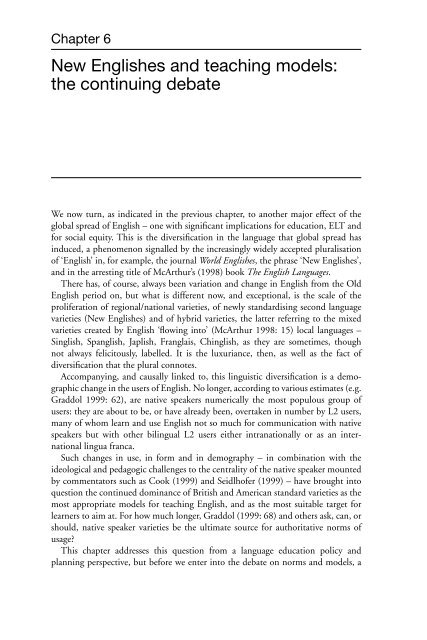Gibson Ferguson Language Planning and Education Edinburgh ...
Gibson Ferguson Language Planning and Education Edinburgh ...
Gibson Ferguson Language Planning and Education Edinburgh ...
You also want an ePaper? Increase the reach of your titles
YUMPU automatically turns print PDFs into web optimized ePapers that Google loves.
Chapter 6<br />
New Englishes <strong>and</strong> teaching models:<br />
the continuing debate<br />
We now turn, as indicated in the previous chapter, to another major effect of the<br />
global spread of English – one with significant implications for education, ELT <strong>and</strong><br />
for social equity. This is the diversification in the language that global spread has<br />
induced, a phenomenon signalled by the increasingly widely accepted pluralisation<br />
of ‘English’ in, for example, the journal World Englishes, the phrase ‘New Englishes’,<br />
<strong>and</strong> in the arresting title of McArthur’s (1998) book The English <strong>Language</strong>s.<br />
There has, of course, always been variation <strong>and</strong> change in English from the Old<br />
English period on, but what is different now, <strong>and</strong> exceptional, is the scale of the<br />
proliferation of regional/national varieties, of newly st<strong>and</strong>ardising second language<br />
varieties (New Englishes) <strong>and</strong> of hybrid varieties, the latter referring to the mixed<br />
varieties created by English ‘flowing into’ (McArthur 1998: 15) local languages –<br />
Singlish, Spanglish, Japlish, Franglais, Chinglish, as they are sometimes, though<br />
not always felicitously, labelled. It is the luxuriance, then, as well as the fact of<br />
diversification that the plural connotes.<br />
Accompanying, <strong>and</strong> causally linked to, this linguistic diversification is a demographic<br />
change in the users of English. No longer, according to various estimates (e.g.<br />
Graddol 1999: 62), are native speakers numerically the most populous group of<br />
users: they are about to be, or have already been, overtaken in number by L2 users,<br />
many of whom learn <strong>and</strong> use English not so much for communication with native<br />
speakers but with other bilingual L2 users either intranationally or as an international<br />
lingua franca.<br />
Such changes in use, in form <strong>and</strong> in demography – in combination with the<br />
ideological <strong>and</strong> pedagogic challenges to the centrality of the native speaker mounted<br />
by commentators such as Cook (1999) <strong>and</strong> Seidlhofer (1999) – have brought into<br />
question the continued dominance of British <strong>and</strong> American st<strong>and</strong>ard varieties as the<br />
most appropriate models for teaching English, <strong>and</strong> as the most suitable target for<br />
learners to aim at. For how much longer, Graddol (1999: 68) <strong>and</strong> others ask, can, or<br />
should, native speaker varieties be the ultimate source for authoritative norms of<br />
usage?<br />
This chapter addresses this question from a language education policy <strong>and</strong><br />
planning perspective, but before we enter into the debate on norms <strong>and</strong> models, a






